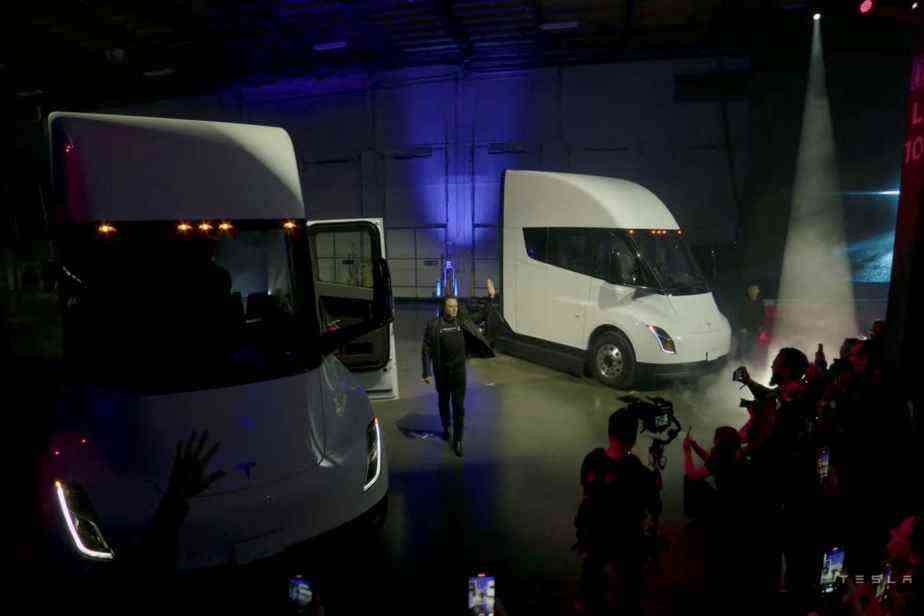(New York) With Elon Musk at the wheel, Tesla delivered its first electric truck on Thursday, attempting to stamp its mark on the nascent emission-free heavy-duty truck market by promising to drive long distances without having to stop at the charging point.
The boss of the manufacturer arrived at the controls of the vehicle, braking a few meters from an audience of guests for the handing over of the keys to the food group PepsiCo, at the Tesla factory in Nevada.
With its cabin with rounded lines for aerodynamics and the driver’s seat placed in the middle, the truck was presented in 2017. But the launch of its large-scale production, initially planned for 2019, has been delayed.
“It’s crazy what has happened in five years […] but here we are, it’s for real, ”said Elon Musk at the start of his presentation.
Other manufacturers have already invested in the niche, whether traditional manufacturers of heavy goods vehicles such as Daimler, Volvo, Traton (a subsidiary of Volkswagen) and the Chinese BYD, or start-ups such as the American Nikola. Deliveries are just beginning but many orders have been placed.

TESLA PHOTO BY REUTERS
Elon Musk
Tesla’s truck was particularly expected because if the group keeps its promises, “it will make a big difference”, notes Dave Mullaney, transport specialist at the sustainable development firm RMI.
Elon Musk repeated it Thursday: the loaded truck, with a total weight of nearly 37 tons, can travel 500 miles (805 kilometers) without recharging, when the vehicles currently on offer offer a range of 250 to 300 miles (400 to 480 kilometers).
Physically possible?
To be able to transport heavy loads over long distances, “the battery has to be very big; it’s heavy, it takes up space and it’s very expensive,” recalls Mike Roeth, director of the North American Council for Freight Efficiency (NACFE). “Industry players have long wondered if it’s physically possible to have a battery that’s powerful enough without being too heavy to do the job. »
The transition to electric vans making deliveries in town or over short distances has been underway for some time.
If electric heavy goods vehicles can travel 800 kilometers without having to recharge, this opens up the niche for long-distance journeys, with a return to the depot the same evening or over several days if the driver can find a terminal where he takes a break.

TESLA PHOTO BY REUTERS
The Tesla Semi electric tractor unit
Manufacturers and carriers are driven by regulations. In the United States, California passed a law providing for the phasing out of thermal engine trucks, since imitated by other states. The European Union is due to discuss new standards in the coming months.
Companies are also increasingly paying attention to being environmentally conscious in order to preserve their reputation. They “want to be on the right side of history”, remarks Marie Chéron, of the European association Transport & Environment.
According to Tesla, large trucks make up 1% of vehicles in the United States but produce 20% of greenhouse gas emissions.
Another incentive for carriers faced with a shortage of truckers, the latter seem to appreciate electric trucks, silent, without fuel smell, without big shock, easier to drive.
Elon Musk also highlighted this point on Thursday by praising the look of the Semi: “If you want the truck that tears the most on the road, this is the one. »
Same cost
For the adoption of electric trucks to accelerate, it is necessary that the autonomy really corresponds to the promises and ideally that the batteries shrink, note several analysts interviewed by AFP.
Infrastructure must also adapt, with more charging stations and an electricity network strong enough to allow, for example, ten trucks to connect to a parking lot at the same time. The price will be decisive.
For the moment, an electric truck still costs about 70% more to purchase than a diesel truck but costs less in terms of energy and maintenance, notes Dave Mullaney.
Tesla had indicated in 2017 that it would offer two versions, at US$150,000 and US$180,000, but has since given no indication of price.
Elon Musk, also busy since the takeover of Twitter, indicated at the end of October that he aimed to build 50,000 Semis in 2024.
